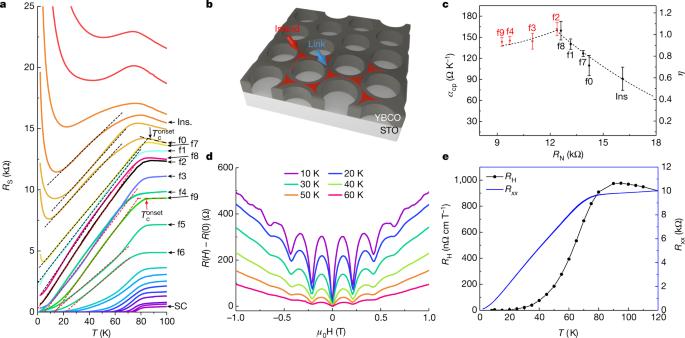玻色系统中奇异金属的特征
IF 50.5
1区 综合性期刊
Q1 MULTIDISCIPLINARY SCIENCES
引用次数: 23
摘要
费米液体理论是我们了解大多数金属的基础:它们的电阻率源于定义明确的准粒子的散射,在低温极限,特征时间尺度的倒数与温度的平方成正比。然而,各种量子材料1-15--尤其是高温超导体1-10--表现出奇怪的金属行为,其散射率与温度呈线性关系,偏离了这一中心范式。在这里,我们展示了一个不适用准粒子概念的玻色子体系中出人意料的奇异金属性特征。我们的纳米图案 YBa2Cu3O7-δ (YBCO) 薄膜阵列在扩展的温度和磁场范围内显示出线性温度电阻和线性磁场电阻。值得注意的是,在库珀对形成的起始温度以下,低磁场磁阻的振荡周期由超导磁通量子 h/2e(e,电子电荷;h,普朗克常数)决定。同时,霍尔系数随着温度的降低而下降,并在测量分辨率内消失,这表明库珀对而不是单个电子在传输过程中占主导地位。此外,该玻色系统中的特征时间尺度τ 遵循一种没有内在能量尺度的尺度不变关系:ħ/τ ≈ a(kBT + γμBB),其中 ħ 是还原的普朗克常数,a 是一阶7,8,11,12,kB 是玻尔兹曼常数,T 是温度,μB 是玻尔磁子,γ ≈ 2。通过将奇异金属现象学的研究范围扩展到玻色系统,我们的研究结果表明,有一种超越粒子统计的基本原理支配着它们的输运。在纳米图案化的 YBa2Cu3O7-δ 玻色子体系中观察到了奇异金属性--特别是与温度和磁场呈线性关系的电阻。本文章由计算机程序翻译,如有差异,请以英文原文为准。

Signatures of a strange metal in a bosonic system
Fermi liquid theory forms the basis for our understanding of the majority of metals: their resistivity arises from the scattering of well defined quasiparticles at a rate where, in the low-temperature limit, the inverse of the characteristic time scale is proportional to the square of the temperature. However, various quantum materials1–15—notably high-temperature superconductors1–10—exhibit strange-metallic behaviour with a linear scattering rate in temperature, deviating from this central paradigm. Here we show the unexpected signatures of strange metallicity in a bosonic system for which the quasiparticle concept does not apply. Our nanopatterned YBa2Cu3O7−δ (YBCO) film arrays reveal linear-in-temperature and linear-in-magnetic field resistance over extended temperature and magnetic field ranges. Notably, below the onset temperature at which Cooper pairs form, the low-field magnetoresistance oscillates with a period dictated by the superconducting flux quantum, h/2e (e, electron charge; h, Planck’s constant). Simultaneously, the Hall coefficient drops and vanishes within the measurement resolution with decreasing temperature, indicating that Cooper pairs instead of single electrons dominate the transport process. Moreover, the characteristic time scale τ in this bosonic system follows a scale-invariant relation without an intrinsic energy scale: ħ/τ ≈ a(kBT + γμBB), where ħ is the reduced Planck’s constant, a is of order unity7,8,11,12, kB is Boltzmann’s constant, T is temperature, μB is the Bohr magneton and γ ≈ 2. By extending the reach of strange-metal phenomenology to a bosonic system, our results suggest that there is a fundamental principle governing their transport that transcends particle statistics. Strange metallicity—in particular, resistance that is linear in temperature and magnetic field—is observed in a nanopatterned YBa2Cu3O7−δ bosonic system.
求助全文
通过发布文献求助,成功后即可免费获取论文全文。
去求助
来源期刊

Nature
综合性期刊-综合性期刊
CiteScore
90.00
自引率
1.20%
发文量
3652
审稿时长
3 months
期刊介绍:
Nature is a prestigious international journal that publishes peer-reviewed research in various scientific and technological fields. The selection of articles is based on criteria such as originality, importance, interdisciplinary relevance, timeliness, accessibility, elegance, and surprising conclusions. In addition to showcasing significant scientific advances, Nature delivers rapid, authoritative, insightful news, and interpretation of current and upcoming trends impacting science, scientists, and the broader public. The journal serves a dual purpose: firstly, to promptly share noteworthy scientific advances and foster discussions among scientists, and secondly, to ensure the swift dissemination of scientific results globally, emphasizing their significance for knowledge, culture, and daily life.
 求助内容:
求助内容: 应助结果提醒方式:
应助结果提醒方式:


